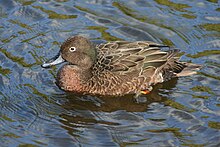Brown teal
| Brown teal | |
|---|---|
 |
|
| Brown Teal | |
| Scientific classification | |
| Kingdom: | Animalia |
| Phylum: | Chordata |
| Class: | Aves |
| Order: | Anseriformes |
| Family: | Anatidae |
| Subfamily: | Anatinae |
| Genus: | Anas |
| Species: | A. chlorotis |
| Binomial name | |
|
Anas chlorotis Gray, 1845 |
|
| Synonyms | |
|
Anas aucklandica chlorotis Elasmonetta chlorotis |
|
Anas aucklandica chlorotis Elasmonetta chlorotis
The brown teal (Anas chlorotis) is a species of dabbling duck of the genus Anas. The Māori name for it is pāteke. For many years it had been considered to be conspecific with the flightless Auckland and Campbell teals in Anas aucklandica; the name "brown teal" has also been largely applied to that entire taxon. Common in the early years of European colonisation, the "brown duck" (as it had been often referred to) was heavily harvested as a food source. Its numbers quickly fell, especially in the South Island, and in 1921 they became fully protected. Captive breeding and releasing into predator-controlled areas has seen good localised populations re-introduced around the country in recent years.
Pateke is the progenitor of the flightless Auckland teal and Campbell teals but all are now recognised as separate species on account of their geographic isolation and their plumage, size and genetic distinctions. The insular A. aucklandica and A. nesiotis are recognised as good species, but are still sometimes referred to as being part of the "brown teal group". The use of the name 'pateke' is now common and is specific for this particular species.
Concerns have been raised about establishing genetically similar populations during re-introduction. The original captive pateke were sourced from Great Barrier Island, where only one haplotype was found in abundance, compared with eleven haplotypes found in the other remaining population at Mimiwhangata. The newly released flocks exclusively contain these birds of captive origin, and diversity is perhaps now not being fully represented in the National population.
The former population of Fiordland brown teal, which died out by 2013 has been replaced with captive-origin birds. Sequencing showed striking similarity to grey duck and mallard sequences, with which they group. It therefore seems extremely likely that the former Fiordland population of brown teal have at sometime in the past hybridised extensively with these invading species
The brown teal is largely nocturnal in habit by dabbling duck standards. This is an evolutionary response to natural diurnal predators such as the New Zealand falcon, Eyles' harrier, or skuas further south in their range. Brown teal have no defense against introduced cats, dogs, stoats & ferrets, which can kill adults & ducklings, or against rats which eat eggs.
...
Wikipedia

